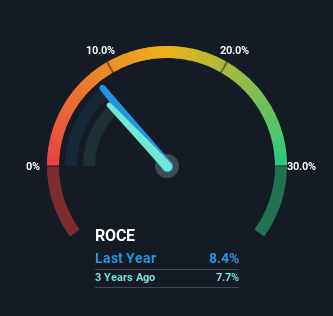Stock Analysis
There's Been No Shortage Of Growth Recently For Vmoto's (ASX:VMT) Returns On Capital

If we want to find a potential multi-bagger, often there are underlying trends that can provide clues. Firstly, we'll want to see a proven return on capital employed (ROCE) that is increasing, and secondly, an expanding base of capital employed. If you see this, it typically means it's a company with a great business model and plenty of profitable reinvestment opportunities. So on that note, Vmoto (ASX:VMT) looks quite promising in regards to its trends of return on capital.
Understanding Return On Capital Employed (ROCE)
For those who don't know, ROCE is a measure of a company's yearly pre-tax profit (its return), relative to the capital employed in the business. The formula for this calculation on Vmoto is:
Return on Capital Employed = Earnings Before Interest and Tax (EBIT) ÷ (Total Assets - Current Liabilities)
0.084 = AU$6.8m ÷ (AU$96m - AU$16m) (Based on the trailing twelve months to December 2023).
Therefore, Vmoto has an ROCE of 8.4%. In absolute terms, that's a low return but it's around the Auto industry average of 9.3%.
Check out our latest analysis for Vmoto

Historical performance is a great place to start when researching a stock so above you can see the gauge for Vmoto's ROCE against it's prior returns. If you're interested in investigating Vmoto's past further, check out this free graph covering Vmoto's past earnings, revenue and cash flow.
What The Trend Of ROCE Can Tell Us
We're delighted to see that Vmoto is reaping rewards from its investments and is now generating some pre-tax profits. Shareholders would no doubt be pleased with this because the business was loss-making five years ago but is is now generating 8.4% on its capital. And unsurprisingly, like most companies trying to break into the black, Vmoto is utilizing 426% more capital than it was five years ago. This can indicate that there's plenty of opportunities to invest capital internally and at ever higher rates, both common traits of a multi-bagger.
In another part of our analysis, we noticed that the company's ratio of current liabilities to total assets decreased to 17%, which broadly means the business is relying less on its suppliers or short-term creditors to fund its operations. This tells us that Vmoto has grown its returns without a reliance on increasing their current liabilities, which we're very happy with.
What We Can Learn From Vmoto's ROCE
In summary, it's great to see that Vmoto has managed to break into profitability and is continuing to reinvest in its business. Investors may not be impressed by the favorable underlying trends yet because over the last five years the stock has only returned 4.5% to shareholders. So exploring more about this stock could uncover a good opportunity, if the valuation and other metrics stack up.
One more thing: We've identified 3 warning signs with Vmoto (at least 1 which doesn't sit too well with us) , and understanding them would certainly be useful.
For those who like to invest in solid companies, check out this free list of companies with solid balance sheets and high returns on equity.
Valuation is complex, but we're helping make it simple.
Find out whether Vmoto is potentially over or undervalued by checking out our comprehensive analysis, which includes fair value estimates, risks and warnings, dividends, insider transactions and financial health.
View the Free AnalysisHave feedback on this article? Concerned about the content? Get in touch with us directly. Alternatively, email editorial-team (at) simplywallst.com.
This article by Simply Wall St is general in nature. We provide commentary based on historical data and analyst forecasts only using an unbiased methodology and our articles are not intended to be financial advice. It does not constitute a recommendation to buy or sell any stock, and does not take account of your objectives, or your financial situation. We aim to bring you long-term focused analysis driven by fundamental data. Note that our analysis may not factor in the latest price-sensitive company announcements or qualitative material. Simply Wall St has no position in any stocks mentioned.
About ASX:VMT
Vmoto
Engages in the development, manufacture, marketing, and distribution of electric two-wheel vehicles worldwide.
Flawless balance sheet and slightly overvalued.


